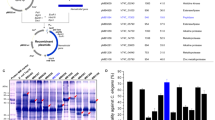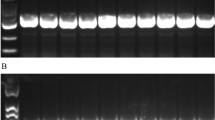Abstract
Bacillus amyloliquefaciens FZB42 has been shown to stimulate plant growth and to suppress the growth of plant pathogenic organisms including nematodes. However, the mechanism underlying its effect against nematodes remains unknown. In this study, we screened a random mutant library of B. amyloliquefaciens FZB42 generated by the mariner transposon TnYLB-1 and identified a mutant strain F5 with attenuated nematicidal activity. Reversible polymerase chain reaction revealed that three candidate genes RAMB_007470, yhdY, and prkA that were disrupted by the transposon in strain F5 potentially contributed to its decreased nematicidal activity. Bioassay of mutants impaired in the three candidate genes demonstrated that directed deletion of gene RBAM_007470 resulted in loss of nematicidal activity comparable with that of the F5 triple mutant. RBAM_007470 has been reported as being involved in biosynthesis of plantazolicin, a thiazole/oxazole-modified microcin with hitherto unknown function. Electrospray ionization time-of-flight mass spectrometry (ESI-TOF-MS) analyses of surface extracts revealed that plantazolicin bearing a molecular weight of 1,354 Da was present in wild-type B. amyloliquefaciens FZB42, but absent in the ΔRABM_007470 mutant. Furthermore, bioassay of the organic extract containing plantazolicin also showed a moderate nematicidal activity. We conclude that a novel gene RBAM_007470 and its related metabolite are involved in the antagonistic effect exerted by B. amyloliquefaciens FZB42 against nematodes.




Similar content being viewed by others
References
Åhman J (2000) Extracellular serine proteases as virulence factors in nematophagous fungi: molecular characterization and functional analysis of the PII protease in Arthrobotrys oligospora. PhD thesis, University of Lund, Lund, Sweden
Arraez-Roman D, Fu SQ, Sawalha SMS, Segura-Carretero A, Fernández-Gutiérrez A (2010) HPLC/CE-ESI-TOF-MS methods for the characterization of polyphenols in almond-skin extracts. Electrophoresis 31:2289–2296
Atibalentja N, Noel GR, Domier LL (2000) Phylogenetic position of the North American isolates of Pasteuria that parasitizes the soybean cyst nematodes, Heterodera glycines, as inferred from 16S rDNA sequence analysis. Int J Syst Evol Microbiol 50:605–613
Bravo A, Sarabia S, Lopez L, Ontiveros H, Abarca C, Ortiz A, Ortiz M, Lina L, Villalobos FJ, Peña G, Nuñez-Valdez ME, Soberón M, Quintero R (1998) Characterization of cry genes in a Mexican Bacillus thuringiensis strain collection. Appl Environ Microbiol 64:4965–4972
Brenner S (1974) The genetics of Caenorhabditis elegans. Genetics 77:71–94
Burkett-Cadena M, Kokalis-Burelle N, Lawrence KS, van Santen E, Kloepper JW (2008) Suppressiveness of root-knot nematodes mediated by rhizobacteria. Biol Control 47:55–59
Cameron DE, Urbach JM, Mekalanos JJ (2008) A defined transposon mutant library and its use in identifying motility genes in Vibrio cholera. Proc Natl Acad Sci U S A 105:8736–8741
Chen XH, Koumoutsi A, Scholz R, Eisenreich A, Schneider K, Heinemeyer I, Morgenstern B, Voss B, Hess WR, Reva O, Junge H, Voigt B, Jungblut PR, Vater J, Süssmuth R, Liesegang H, Strittmatter A, Gottschalk G, Borriss R (2007) Comparative analysis of the complete genome sequence of the plant growth-promoting bacterium Bacillus amyloliquefaciens FZB42. Nat Biotechnol 25:1007–1014
Crickmore N (2005) Using worms to better understand how Bacillus thuringiensis kills insects. Trends Microbiol 13:347–350
Datta V, Myskowski SM, Kwinn LA, Chiem DN, Varki N, Kansal RG, Kotb M, Nizet V (2005) Mutational analysis of the group A streptococcal operon encoding streptolysin S and its virulence role in invasive infection. Mol Microbiol 56:681–695
Dietel K, Beator B, Budiharjo A, Fan B, Borriss R (2013) Bacterial traits involved in colonization of Arabidopsis thaliana roots by Bacillus amyloliquefaciens FZB42. Plant Pathol J 29:59–66
Duncon LW (1991) Current options for nematode management. Annu Rev Phytopathol 29:469–490
Earl AM, Eppinger M, Fricke WF, Rosovitz MJ, Rasko DA, Daugherty S, Losick R, Kolter R, Ravel J (2012) Whole-genome sequences of Bacillus subtilis and close relatives. J Bacteriol 194:2378–2379
Ebert D, Rainey P, Embley TM, Scholz D (1996) Development, life cycle, ultrastructure and phylogenetic position of Pasteuria ranosa Metchnikoff 1888: rediscovery of an obligate endoparasite of Daphnia magna Straus. Philos Trans R Soc Lond B 351:1689–1701
Fischer C, Geourjon C, Bourson C, Deutscher J (1996) Cloning and characterization of the Bacillus subtilis prkA gene encoding a novel serine protein kinase. Gene 168:55–60
Garsin DA, Sifri CD, Mylonakis E, Qin X, Singh KV, Murray BE, Calderwood SB, Ausubel FM (2001) A simple model host for identifying Gram-positive virulence factors. Proc Natl Acad Sci U S A 98:10892–10897
Garvis S, Munder A, Ball G, Bentzmann SD, Wiehlmann L, Ewbank JJ, Tümmler B, Filloux A (2009) Caenorhabditis elegans semi-automated liquid screen reveals a specialized role for the chemotaxis gene cheB2 in Pseudomonas aeruginosa virulence. PLoS Pathog 5(8):1–13
Haft DH, Basu MK, Mitchell DA (2010) Expansion of ribosomally produced natural products: a nitrile hydratase- and Nif11-related precursor family. BMC Biol 8:70
Huang XW, Tian BY, Niu QH, Yang JK, Zhang LM, Zhang KQ (2005) An extracellular protease from Brevibacillus laterosporus G4 without parasporal crystal can serve as a pathogenic factor in infection of nematodes. Res Microbiol 156:719–727
Idris ESE, Iglesias DJ, Talon M, Borriss R (2007) Tryptophan-dependent production of indole-3-acetic acid (IAA) affects level of plant growth promotion by Bacillus amyloliquefaciens FZB42. Mol Plant Microbe Interact 20:619–626
Kalyon B, Helaly SE, Scholz R, Nachtigall J, Vater J, Borriss R, Süssmuth RD (2011) Plantazolicin A and B: structure elucidation of ribosomally synthesized thiazole/oxazole peptides from Bacillus amyloliquefaciens FZB42. Org Lett 13:2996–2999
Kotze AC, O'Grady J, Gough JM, Pearson R, Bagnall NH, Kemp DH, Akhurst RJ (2005) Toxicity of Bacillus thuringiensis to parasitic and free-living life stages of nematodes parasites of livestock. Int J Parasitol 35:1013–1022
Kunst F, Rapoport G (1995) Salt stress is an environmental signal affecting degradative enzyme synthesis in Bacillus subtilis. J Bacteriol 177:2403–2407
Kurz CL, Ewbank JJ (2000) Caenorhabditis elegans for the study of host–pathogen interactions. Trends Microbiol 8:142–144
Kurz CL, Chauvet S, Andres E, Aurouze M, Vallet I, Michel GPF, Uh M, Celli J, Filloux A, Bentzmann SD, Steinmetz I, Hoffmann JA, Finlay BB, Gorvel JP, Ferrandon D, Ewbank JJ (2003) Virulence factors of the human opportunistic pathogen Serratia marcescens identified by in vivo screening. EMBO J 22:1451–1460
Le Breton YL, Mohapatra NP, Haldenwang WG (2006) In vivo random mutagenesis of Bacillus subtilis by sse of TnYLB-1, a mariner-based transposon. Appl Environ Microbiol 72:327–333
Lewis JA, Fleming JT (1995) Basic culture methods. In: Epstein HF and Shakes DC (eds) Caenorhabditis elegans: modern biological analysis of an organism. Academic, San Diego, CA, pp 3–29
Li YM, Milne JC, Madison LL, Kolter R, Walsh CT (1996) From peptide precursors to oxazole and thiazole-containing peptide antibiotics: microcin B17 synthase. Science 274:1188–1193
Marroquin LD, Elyassnia D, Griffitts JS, Feitelson JS, Aroian RV (2000) Bacillus thuringiensis (Bt) toxin susceptibility and isolation of resistance mutants in the nematode Caenorhabditis elegans. Genetics 155:1693–1699
Milne JC, Roy RS, Eliot AC, Kelleher NL, Wokhlu A, Nickels B, Walsh CT (1999) Cofactor requirements and reconstitution of microcin B17 synthetase: a multienzyme complex that catalyzes the formation of oxazoles and thiazoles in the antibiotic microcin B17. Biochemistry 38:4768–4781
Molohon K, Melby JO, Lee J, Evans BS, Dunbar KL, Bumpus SB, Kelleher NL, Mitchell DA (2011) Structure determination and interception of biosynthetic intermediates for the plantazolicin class of highly discriminating antibiotics. ACS Chem Biol 16:1307–1313
Niu QH, Huang XW, Zhang L, Yang JK, Zhang KQ (2006) A neutral protease from Bacillus nematocida, another potential virulence factor in the infection against nematodes. Arch Microbiol 185:439–448
Niu QH, Huang XW, Zhang L, Lian LH, Li YX, Li J, Yang JK, Zhang KQ (2007) Functional identification of the gene bace16 from nematophagous bacterium Bacillus nematocida. Appl Microbiol Biotechnol 75:141–148
O'Quinn AL, Wiegand EM, Jeddeloh JA (2001) Burkholderia pseudomallei kills the nematode Caenorhabditis elegans using an endotoxin-mediated paralysis. Cell Microbiol 3:381–393
Qin X, Singh KV, Weinstock GM, Murray BE (2000) Effects of Enterococcus faecalis fsr genes on production of gelatinase and a serine protease and virulence. Infect Immun 68:2579–2586
Schneider SM, Rosskopf EN, Leesch JG, Chellemi DO, Bull CT, Mazzola M (2003) Research on alternatives to methyl bromide: pre-plant and post-harvest. Pest Manag Sci 59:814–826
Scholz R, Molohon KJ, Nachtigall J, Vater J, Markley AL, Süssmuth RD, Mitchell DA, Borriss R (2011) Plantazolicin, a novel microcin B17/streptolysin S-like natural product from Bacillus amyloliquefaciens FZB42. J Bacteriol 193:215–224
Shin-ya K, Wierzba K, Matsuo K, Ohtani T, Yamada Y, Furihata K, Hayakawa Y, Seto H (2001) Telomestatin, a novel telomerase inhibitor from Streptomyces anulatus. J Am Chem Soc 131:1262–1263
Sifri CD, Mylonakis E, Singh KV, Qin X, Garsin DA, Murray BE, Ausubel FM, Calderwood SB (2002) Virulence effect of Enterococcus faecalis protease genes and the quorum-sensing locus fsr in Caenorhabditis elegans and mice. Infect Immun 70:5647–5650
Tian BY, Yang JK, Zhang KQ (2007) Bacteria used in the biological control of plant-parasitic nematodes: populations, mechanisms of action, and future prospects. FEMS Microbiol Ecol 61:197–213
Tikhonov VE, Lopez-Llorca LV, Salinas J, Jansson HB (2002) Purification and characterization of chitinases from the nematophagous fungi Verticillium chlamydosporium and V. suchlasporium. Fungal Genet Biol 35:67–78
Valverde A, Aguilera A, Ferrer CA, Camacho F, Cammarano A (2010) Analysis of forchlorfenuron in vegetables by LC/TOF-MS after extraction with the buffered QuEChERS method. J Agric Food Chem 58:2818–2823
Wei JZ, Hale K, Carta L, Platzer E, Wong C, Fang SC, Aroian RV (2003) Bacillus thuringiensis crystal proteins that target nematodes. Proc Natl Acad Sci U S A 100:2760–2765
Xia YF, Xie SS, Ma X, Wu HJ, Wang X, Gao XW (2011) The purL gene of Bacillus subtilus is associated with nematicidal activity. FEMS Microbiol Lett 322:99–107
Acknowledgments
We thank Prof. Jianping Xu, from McMaster University in Canada, for his constructive criticism for this manuscript. This work is supported by the National Basic Research Program of China (grant nos. 2011AA10A203 and 2013CB127500), the National Natural Science Foundation Program of China (grant nos. 30970065 and U1036602), and the Department of Science and Technology of Yunnan Province (grant no. 2010GA012).
Author information
Authors and Affiliations
Corresponding author
Rights and permissions
About this article
Cite this article
Liu, Z., Budiharjo, A., Wang, P. et al. The highly modified microcin peptide plantazolicin is associated with nematicidal activity of Bacillus amyloliquefaciens FZB42. Appl Microbiol Biotechnol 97, 10081–10090 (2013). https://doi.org/10.1007/s00253-013-5247-5
Received:
Revised:
Accepted:
Published:
Issue Date:
DOI: https://doi.org/10.1007/s00253-013-5247-5




